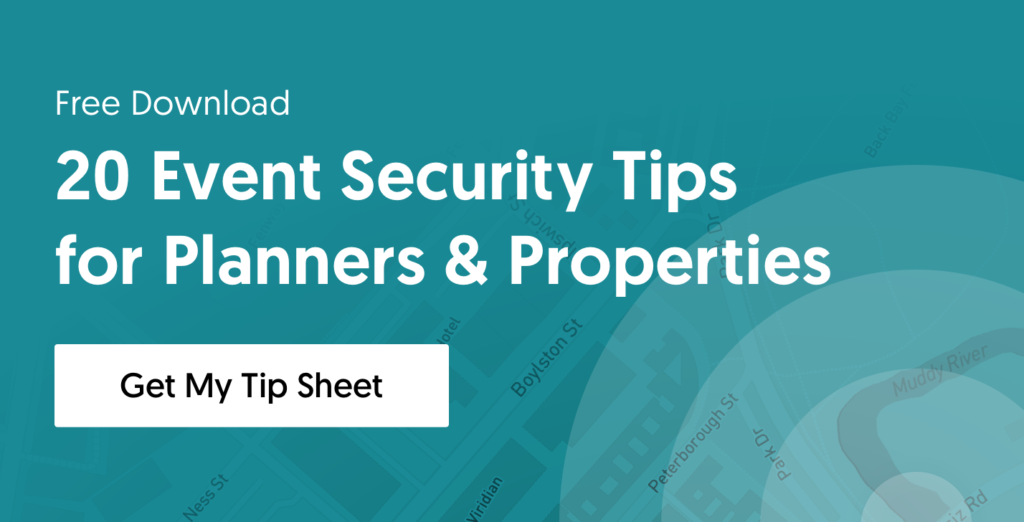
Crowd Control Tips: 3 Best Practices for Venues
Venue managers and staff all have a duty to their attendees to provide a level of crowd management and safe, fun experiences at events. This is first and foremost vital for guest and staff safety, as well as minimizing complaints that may lead to a poor event review.
As part of the planning process, be sure to exercise these three best practices for crowd management at your next large-scale event.

Try these crowd control tips at your next event:
Tip #1: Have plenty of ushers and security on-hand
A big event calls for a large staff presence. This will mainly consist of event staff but also event security personnel provided by the venue or hired from a third-party service. There should also be an easy way to locate a guest service desk or station where guests can go for questions instead of having to flag down a busy staff member.
Your venue staff should also include ushers who are responsible for customer-related services, such as escorting guests to their seats, maintaining order in the check-in line, or showing attendees where to go.
Speaking of check-in lines, this is one area that can quickly become chaotic. Stragglers may cut in line or gather to the side and block the entrance.
Instead, designate the check-in lines or entrances with stanchions and have ushers guide people to the correct line if there are multiple registration/sign-in areas. Clearly mark specific areas, like VIP ticket holders, will call, or ticket purchase windows.
As for security, these are the people designated to keep the peace. Ushers shouldn’t confront unruly attendees; they should leave that to the security. When it comes to a possible safety issue involving guests, ushers should get security involved as soon as possible. These are the pros who know how to manage crowds at events the best. Security should also be responsible for checking bags for weapons and other banned substances at check-in.
[Tweet “Crowd management for large events is vital for safety and the enjoyment of everyone in attendance.”]
Tip #2: Prep the venue with lots of signage
Attendees are going to be navigating around a crowded (possibly dark) venue that they have likely never stepped foot into. Ensure guests know their way around by using plenty of signs to point people in the right direction. This can include signs for:
- directions to the nearest restroom
- where the line begins for the registration
- designated smoking areas
- locations to exhibits or workshops
- restricted or staff-only areas
Signs should be simple with print that’s large enough to read from afar. For venues that have repeat event types (such as concerts, VIP events, or galas) you may want to invest in creating reusable signage or purchasing some form of digital signage. The latter can also regularly swap out the signs for promotional ads.
Having signs prominently displayed helps to keep the venue space orderly and ensures attendees find their way around the event.

Tip #3: Have an emergency plan just in case
You always have to plan for the worst-case scenario. So many things can go wrong that will require an orderly evacuation or in the event of a security breach. This could include the breakout of a fire, sudden weather changes, a brawl in the crowd, acts of terrorism, or attendees bringing in weapons. Any of these scenarios may require attendees to exit the venue until law enforcement or firefighters arrive.
Venue managers should know the venue layout and where all the exits are. Staff should also be the last people to exit. It’s their job to maintain order and ensure attendees leave safely.
It’s all too easy to assume that nothing can ever go wrong. However, it’s imperative your staff is mentally prepared to handle the unexpected. There have been numerous reports over the years of melee and pandemonium taking place at an event.
[Tweet “Have an emergency plan just in case, for both indoor and outdoor events.”]
Your safety plan should also include a plan even if the event takes place outdoors. In 2015, 15 people died at an outdoor concert held at a water park in Taiwan after an explosion occurred. These scenarios are extremely rare occurrences, but they can (and do) happen. As the venue manager, it’s your responsibility to be ready for immediate assistance, crowd management, and maintaining calm and order.
With a large event turnout comes a large amount of responsibility. It’s the venue manager’s duty to ensure a fun, memorable, and, most importantly, a safe event with proper crowd control methods.
Up next, discover even more event security tips to minimize your risk.
Download our quick checklist of 20 event security tips and tactics to help you prepare like a pro!

Have some more questions about crowd control?
Crowd control is important to provide safe, fun experiences at events. This is vital for guest and staff safety, as well as minimizing complaints that may lead to a poor event review.
Crowd control means that large crowds are managed to prevent the outbreak of potential problems or hazards that can result when large crowds are gathered. These hazards can include crowd crush, conflict, and even riots.

